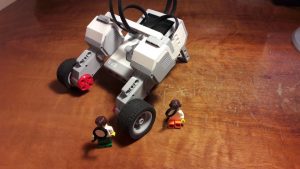Από: ΜΑΡΓΑΡΙΤΑ ΧΑΤΖΟΥΛΗ
Η ρομποτική είναι ένας συνεχώς αναπτυσσόμενος επιστημονικός κλάδος, ο οποίος τα τελευταία χρόνια απασχολεί εκτός από εξειδικευμένους επιστήμονες ,και σπουδαστές μικρότερης ηλικίας. Η εκπαιδευτική ρομποτική είναι η πλέον δελεαστική εξωσχολική δραστηριότητα.
Ένα παιδί έχει την δυνατότητα να έρθει σε επαφή με τον μαγικό κόσμο της ρομποτικής σε ηλικία 6 ετών, ενώ η ενασχόλησή του αυτή μπορεί να τον συνοδεύει σε όλη την σχολική του ζωή μέχρι και το τέλος του λυκείου. Τι είναι όμως αυτό που κάνει τα παιδιά να την επιλέξουν και να την αγαπήσουν; Τι τους προσφέρει;
Απαντώντας στα ερωτήματα αυτά τα 5 κυριότερα, κατά την άποψή μου οφέλη που μπορεί να αποκομίσει ένας μικρός μας σπουδαστής είναι τα εξής :
- Απόκτηση ομαδικού πνεύματος. Τα παιδιά μαθαίνουν να δουλεύουν σε ομάδες. Το ρομπότ τους δεν θα πετύχει τον σκοπό του αν δεν ξέρουν να συνεργάζονται-να εκφράζονται αλλά και να ακούνε .Διαφορετικοί χαρακτήρες μαθαίνουν να επικοινωνούν μεταξύ τους, αξιοποιώντας ο καθένας τα δυνατά του σημεία ,με σκοπό την επιτυχία της ομάδας.
- Επαφή με νέες τεχνολογίες. Η εκπαιδευτική ρομποτική εισάγει τους μαθητές στον προγραμματισμό και στην μηχανική με τρόπο διασκεδαστικό και συναρπαστικό .Έτσι πολύ σύντομα μαθαίνουν να σκέφτονται ως μηχανικοί και εξοικειώνονται με τα καινούργια τεχνολογικά μέσα.
- Ευκολότερη κατανόηση της τεχνολογίας. Λέγεται ότι, ό,τι διδαχθεί ένα παιδί με ζωντανό και παραστατικό τρόπο θα το θυμάται μία ζωή. Η βιωματική μάθηση είναι ο μαγνήτης που έλκει τα νεαρά μυαλά να φοιτήσουν στην Ακαδημία μας. Ο τρόπος αυτός διδασκαλίας είναι επίσης ο καταλληλότερος για παιδιά με ειδικές ανάγκες και ικανότητες ,καθώς , όντας οπλισμένα με μοναδικά πλεονεκτήματα ,έχουν την τάση να κατανοούν οτιδήποτε είναι ενδιαφέρον και περιλαμβάνει διασκέδαση, ανεξάρτητα από το πόσο δύσκολο και σύνθετο μπορεί να είναι.
- Διεύρυνση του ορίζοντά του και ανακάλυψη νέων ικανοτήτων του. Κατά την διάρκεια ενός μαθήματος και μέσα από την διαδικασία κατασκευής ενός ρομπότ ,οι μαθητές έρχονται σε επαφή με επιστήμες όπως η φυσική, τα μαθηματικά, η μηχανική. Είναι εκπληκτικό να βλέπεις τα παιδιά μας να συναρπάζονται από κλάδους που ποτέ δεν πίστευαν ότι θα αγαπούσαν!
- Διασκέδαση. Τα παιδιά αυτό που θέλουν και χρειάζονται είναι να κάνουν κάτι γεμάτο διασκέδαση. Αγαπούν την επαφή με τον υπολογιστή ή το τάμπλετ και τα αυτόματα παιχνίδια . Φανταστείτε λοιπόν τον ενθουσιασμό τους όταν έχουν την ευκαιρία να κατασκευάσουν το δικό τους ρομπότ , να το προγραμματίσουν και τέλος να το παρουσιάσουν με υπερηφάνεια στους γονείς τους!
Πέραν αυτών τα μαθήματα ρομποτικής αποτελούν επένδυση για το μέλλον των παιδιών αφού η ρομποτική ήρθε στην ζωή μας για να μείνει .Οι γνώσεις που θα αποκομίσουν θα τους χρησιμεύσουν είτε ασχοληθούν ενεργά με αυτόν τον κλάδο είτε όχι, καθώς τα επιτεύγματα της ρομποτικής αποτελούν σήμερα –και σε ακόμη μεγαλύτερο βαθμό στο μέλλον- αναπόσπαστο κομμάτι της καθημερινότητάς μας.
Τα παιδιά ,έχοντας να αντιμετωπίσουν έναν απαιτητικό και συνεχώς εξελισσόμενο τεχνολογικά κόσμο θα πρέπει να γεμίσουν την φαρέτρα τους με πολύτιμες εμπειρίες και γνώσεις. Η εκπαιδευτική ρομποτική τα εφοδιάζει με βασικές γνώσεις μηχανικής, σημαντικά μαθήματα ζωής αλλά και με όμορφες αναμνήσεις που θα τα συντροφεύουν για πάντα.
https://www.robotics.uom.gr/post/163/ekpaideutiki-rompotiki-hrthe-gia-na-meinei








